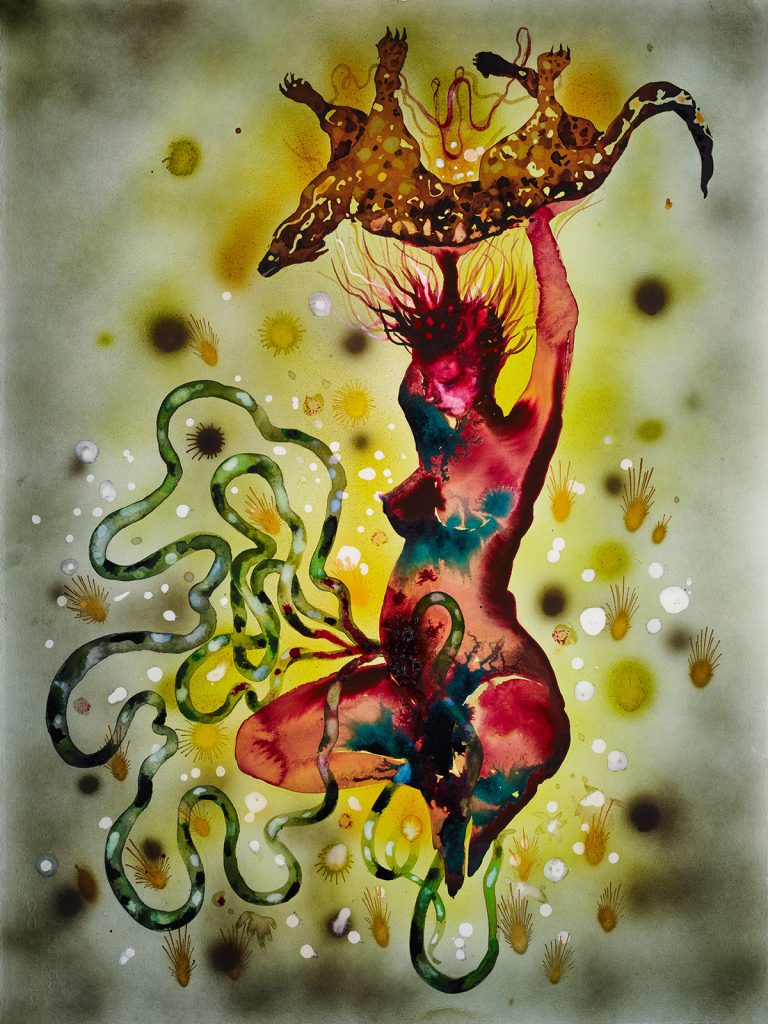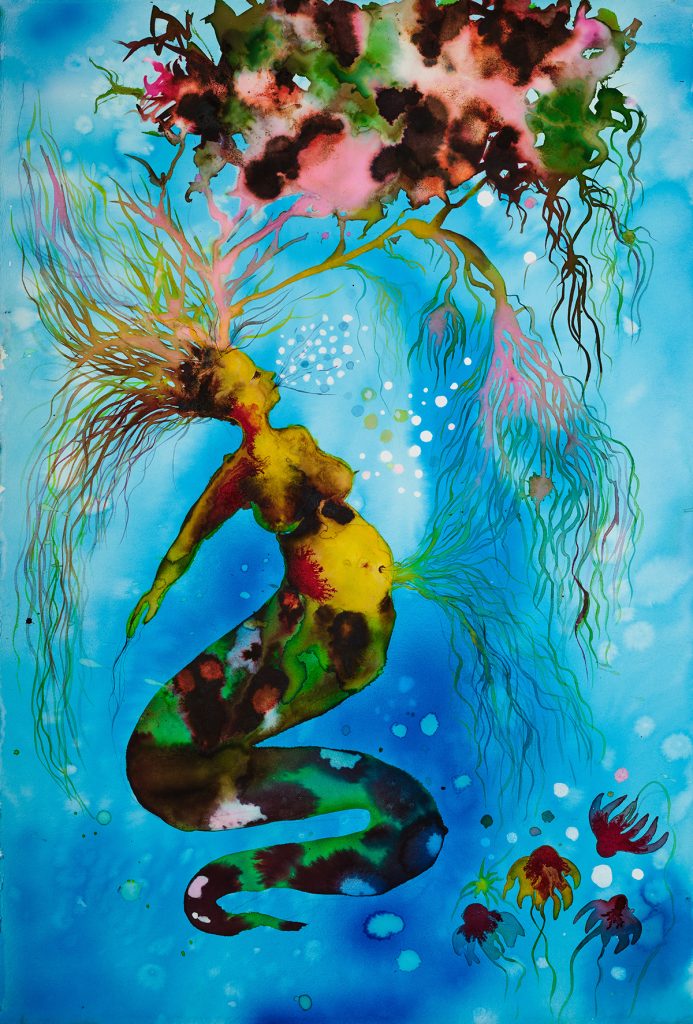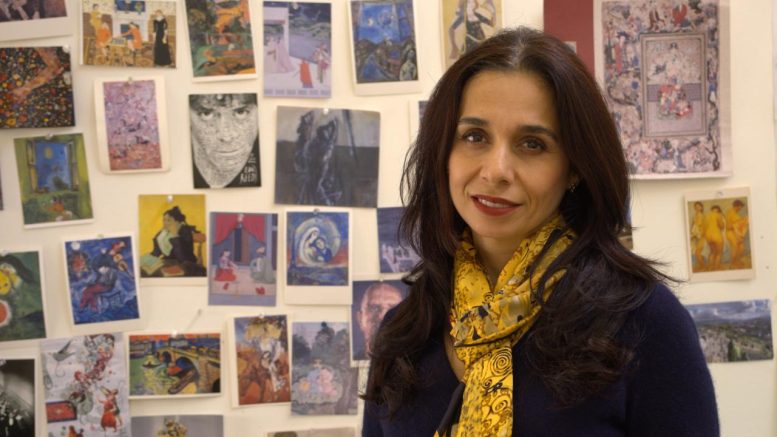By Jeffrey Day
Shiva Ahmadi’s art encompasses and expresses her personal and political concerns, anxieties, fears and joys. But her art is not polemical nor pedantic, nor so personal that it cannot connect with others.
“I am a political person,” said Ahmadi, a UC Davis College of Letters and Science professor in the Department of Art and Art History. “I don’t want to be, but as an Iranian, an immigrant and a woman, you have to keep up with politics. I don’t want to make beautiful art that’s for decoration. I haven’t had the opportunity in my life to be concerned with beauty of formal elements.”
All of that can be seen in “Shiva Ahmadi: Strands of Resilience,” an exhibition of 19 paintings at the Jan Shrem and Maria Manetti Shrem Museum of Art at UC Davis Jan. 28 through May 6.
While Ahmadi’s art is informed by conflicts in the Middle East, repression in her native Iran, and the divisive political and social milieu in the U.S., it is never specifically about those issues. Her paintings are metaphors, but what they are metaphors for is up to the viewer. And what they mean to Ahmadi emerges and changes throughout the creation process and even long after it. Sometimes they address events and issues that hadn’t even happened when she was making them, like the current war in Gaza. It’s as if history catches up with her art.
“I’m still discovering things in them,” she said. “The story comes after.”
New approach emerged during the pandemic

During the pandemic, isolated and filled with anxiety, Ahmadi increased her long-standing practice of making many rapid drawings and paintings, often of the human figure.
“Then I realized, ‘Oh look, they’re all women,’” Ahmadi said. “It was totally unconscious.”
In many of her earlier works, the central figure was a domineering and despotic man. By contrast, the female figures are imbued with and exude a protective power; it’s a power gained through pain and struggle.
“They’re scarred, missing arms and legs,” Ahmadi said. “But they’re still standing and strong.”
The figures became the driving force in her recent paintings.
Ahmadi’s earlier paintings, and several animations, have been up to 5-by-10 feet in size and packed with buildings, boats, walls, pipelines, oil tankers, mosques, minarets, castles, thrones, birds, horses and dozens of human figures. She wanted to find a way to load up and layer meanings and content in a different way. She found a new visual resource in news photos of bombed and burned cities in war and conflict zones around the world. In many of them, children can be seen playing in the rubble, sometimes even finding toys.
“There’s a sense of hope and resiliency in that,” she said.
Like the female figures, the children find a way through the horror.
Using silk-screening, Ahmadi printed black-and-white images of the news photos onto paper, then began painting. Using both techniques gave her a new way to tell a story with multiple layers, both emotionally and physically. It was a struggle of back and forth between the linear, black-and-white photographic images, and the jewel-like colors and fluid watercolor paint.
“You can’t erase anything or paint over the watercolor, and it’s the same with the printing,” she said. “You have to work around it and keep going.”
“Like politics,” she said, having found another after-the-fact metaphor. Like those female figures, like the kids in the photos.
The content of the work was also fueled by Ahmadi’s awareness of the body’s vulnerability, physically and legally. First there was the pandemic; then in June 2022 the U.S. Supreme Court overturned Roe v. Wade, which had given women the right to an abortion. A few months later Mahsa Amini, a young woman in Iran, died after being arrested and beaten by police for not following strict women’s attire laws. Her death led to widespread protests in Iran, more arrests and more deaths that are ongoing.
New work and a first for faculty member

Ahmadi’s solo exhibition is the first at the Manetti Shrem Museum by a current UC Davis art faculty member.
Exhibition curator Susie Kantor first contacted Ahmadi to include one of her video animations in “From Moment to Movement: Picturing Protest in the Kramlich Collection,” a video and film exhibition at the museum in 2022. Kantor, associate curator and exhibition department head at the museum, knew then that she wanted to work with Ahmadi on an exhibition. All the works in the show were made during 2023 specifically for this exhibition.
Ahmadi’s art “lives in the intersection of beauty and horror, and the tension between the two animates all her creations,” according to Kantor.
While Kantor definitely views Ahmadi as a political artist, she also considers her an artist’s artist.
“She’s thinking, ‘What can painting mean and what can I do with it that’s interesting?’” Kantor said. “It’s not something you see every artist do.”
By Jeffrey Day, who was a content strategist and writer at UC Davis College of Letters and Science when this was written. Originally publish on the UC Davis College of Letters and Science website.


Be the first to comment on "Essay: Working out the personal and political in paint with Shiva Ahmadi"